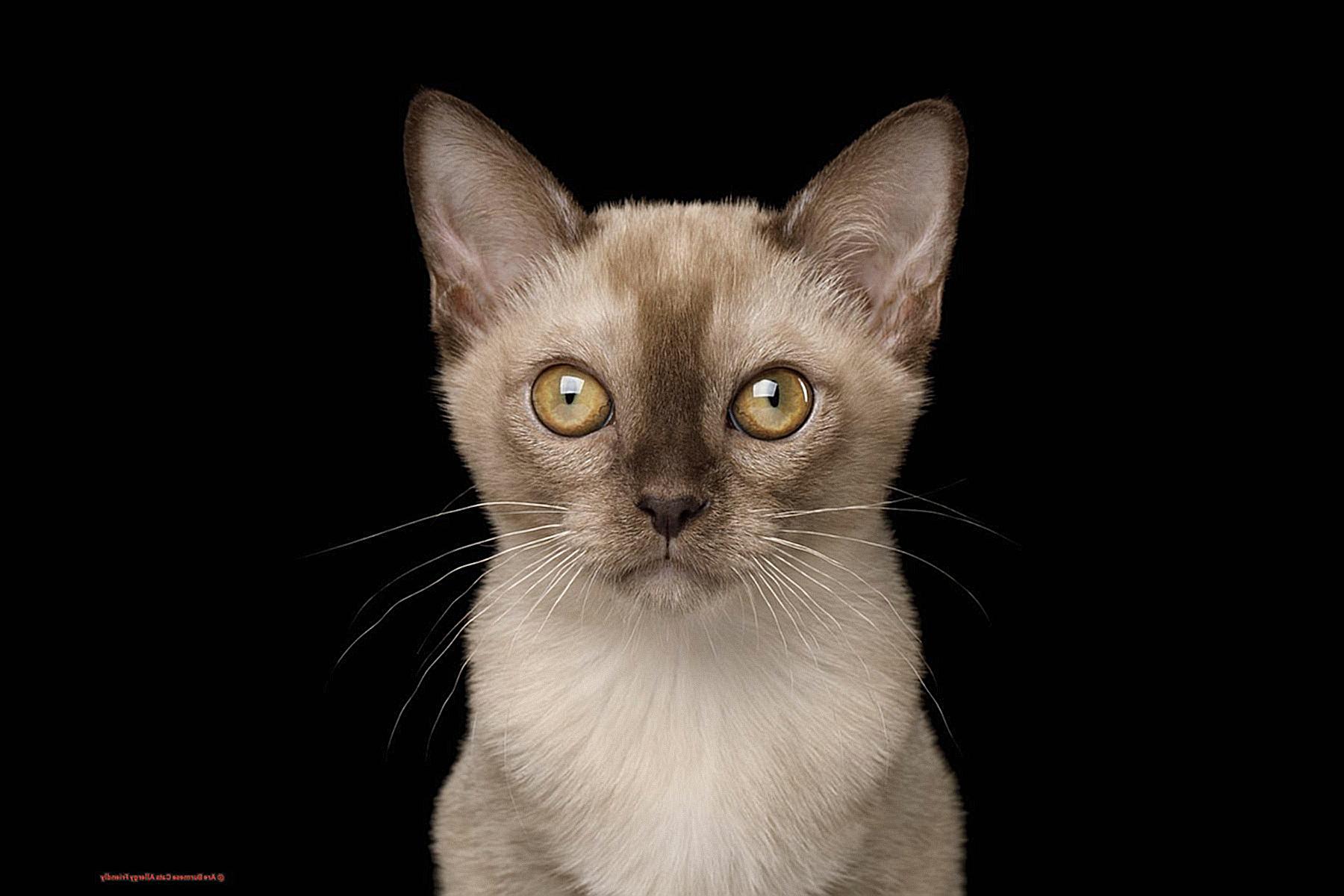Are you tired of constantly sneezing and itching around your furry feline friend? Well, let me introduce you to the hypoallergenic wonder that is the Burmese cat.
Not only are these kitties absolutely gorgeous and super affectionate, but they also have a unique ability to minimize allergic reactions in their owners. As someone who loves cats but also suffers from allergies, I was beyond excited to discover the hypoallergenic qualities of Burmese cats.
Trust me, your nose will thank you later.
Are Burmese Cats Allergy Friendly?
Contents
There are certain cat breeds that are considered more allergy-friendly than others. And one of these breeds is the playful and affectionate Burmese cat.
But what makes Burmese cats allergy friendly? Let’s dive deeper into this topic and explore why this breed may be a suitable option for those with allergies.
The Truth About Cat Allergies
Firstly, it’s important to understand that there is no such thing as a completely hypoallergenic cat. All cats produce allergens in their saliva, dander, and urine, which can trigger allergic reactions in humans. However, some breeds are known to produce fewer allergens and are therefore considered more allergy-friendly.
Burmese Cats and Allergies
According to the American College of Allergy, Asthma and Immunology, Burmese cats are considered one of the most allergy-friendly breeds. This is because they have a short and silky coat that produces less dander compared to other breeds. Dander is the dead skin cells that shed from an animal’s body, which can contain allergens. With less dander production, Burmese cats may be a better option for those with allergies.
Grooming Habits
Another factor that makes Burmese cats allergy friendly is their low grooming needs. Unlike other long-haired breeds that require frequent brushing to prevent matting and excessive shedding, Burmese cats have minimal grooming requirements. This means there is less chance of allergens being spread around the house through grooming.
Saliva Production
In addition to their coat and grooming habits, Burmese cats also produce less saliva compared to other breeds. Saliva contains a protein called Fel d 1, which is a common allergen for humans. With lower levels of this protein present in their saliva, Burmese cats may cause fewer allergic reactions in sensitive individuals.
Tips for Living with a Burmese Cat
If you do decide to bring home a Burmese cat, there are some steps you can take to further minimize allergens in your home. These include keeping the cat out of bedrooms and other areas where you spend most of your time, using a HEPA air purifier to filter out allergens, and regularly cleaning and vacuuming your home.
Do Burmese cats cause allergies?
As a cat lover, you may have heard that Burmese cats are a great option for those with allergies. But is there any truth to this claim? Let’s dive into the science behind cat allergies and how the Fel d 1 protein found in Burmese cats can trigger allergic reactions.
What is Fel d 1 and How Does it Cause Allergies?
Fel d 1 is a protein found in cat saliva, sebaceous glands (oil glands in the skin), and dander (dead skin cells). When a cat grooms itself, the protein is released into their fur, where it can easily be spread around the house. When sensitive individuals come into contact with this protein, it can trigger an allergic reaction.
Why Do Burmese Cats Still Cause Allergies?
While it is true that Burmese cats produce less of the Fel d 1 protein compared to other breeds, they still produce enough to cause allergies in sensitive individuals. This is because there is no such thing as a truly hypoallergenic cat. It all depends on an individual’s unique genetic makeup and immune system response.
What Can You Do if You Have Allergies?
If you have allergies to cats, consult with your doctor before bringing a Burmese cat into your home. They can help determine if you are sensitive to Fel d 1 and provide recommendations for managing your allergies.
Tips for Living Comfortably with a Burmese Cat
Despite the potential for causing allergies, many people with mild cat allergies have found that they can still live comfortably with a Burmese cat by taking certain precautions. Here are some tips:
- Regularly groom and bathe your cat to reduce the amount of allergens on their fur.
- Use air purifiers to minimize allergens in the air.
- Keep your home clean and vacuum often to remove any lingering allergens.
- Consider allergy shots or medication to help manage your symptoms.
Burmese Cats and “Hypoallergenic” Claims
You may have come across breeders claiming to have “hypoallergenic” Burmese cats. However, there is no scientific evidence to support this claim. It is important to do thorough research and consult with a reputable breeder before purchasing a cat for its hypoallergenic properties.
Factors that make Burmese cats allergy friendly
One of the main reasons Burmese cats are considered allergy friendly is because of their short and silky coat. This type of coat requires minimal grooming, which means less shedding and fewer allergens present on their fur. This is great news for allergy sufferers as it reduces the amount of dander and saliva that can trigger allergic reactions.
Low Levels of Fel d 1 Protein
While it’s true that all cats produce Fel d 1 protein, the main allergen found in cat saliva, Burmese cats tend to produce lower levels of it compared to other breeds. This is due to their genetic makeup and selective breeding over the years. However, it’s important to note that no cat is completely hypoallergenic as they all produce this protein to some degree.
Single Coat
Burmese cats also have a single coat rather than a double coat like many other breeds. This means they shed less hair and produce fewer allergens, making them easier to manage for those with allergies. With less hair to clean up and less likelihood of allergens spreading throughout the house, owning a Burmese cat can be a lot more manageable for those with allergies.
Grooming Habits and Cleanliness
Another factor that makes Burmese cats allergy friendly is their grooming habits and cleanliness. These cats are not known to be excessive groomers, which means they have less saliva on their fur. Additionally, they are very clean animals and will often use a litter box to keep themselves groomed, reducing the amount of allergens they spread around the house.
Low-Maintenance Grooming Needs
Burmese cats have low-maintenance grooming needs, which is a huge plus for allergy sufferers. They do not require frequent baths or brushing, making it easier to manage allergies while still being able to care for a pet. This also means less stress for the cat, as grooming sessions can be stressful for them.
Tips for living with a Burmese cat if you have allergies
Look no further than the Burmese cat. These adorable and affectionate cats have gained popularity as household pets in recent years, and for good reason. As an expert on living with a Burmese cat despite allergies, I am here to share my top tips for a harmonious relationship with your new fur baby.
First and foremost, it is important to address the common misconception that all cats cause allergies. While it is true that their saliva and dander can trigger symptoms, not all cat breeds are created equal. Burmese cats produce less of the protein Fel d 1, which is the main culprit behind allergic reactions. This makes them a great option for people with allergies.
But before bringing home a Burmese cat, it is important to spend some time with the specific cat you are interested in. This will give you the opportunity to see how your body reacts to their dander and saliva. It is also recommended to get allergy testing done beforehand to determine if you are allergic specifically to cats or if there are other allergens present that may be affecting your symptoms.
Once you have decided to bring home a Burmese cat, there are steps you can take to minimize allergens in your home. Regular grooming and brushing of your cat’s fur can significantly reduce the amount of dander present. Investing in a high-quality air purifier can also help filter out allergens from the air. And as with any pet, keeping your home clean and dust-free is crucial. Vacuuming frequently, using dust-proof covers on furniture, and washing bedding regularly can all make a difference.
In addition to these measures, incorporating natural remedies into your diet can also help boost your immune system and lessen the impact of allergies. Probiotics and omega-3 fatty acids have been known to reduce inflammation and make allergies more manageable.
If your allergies are severe, it may be necessary to consult with an allergist who can provide medication or immunotherapy options to help control symptoms. It is important to discuss any potential risks or concerns with these treatments with your healthcare provider.

The hypoallergenic quality of Burmese cats
Are you a cat lover but suffer from allergies? Look no further than the charming and affectionate Burmese cat. This breed has been known for its hypoallergenic qualities, making them a popular choice for individuals with sensitivities to allergens. But what exactly makes Burmese cats hypoallergenic? Let’s explore the factors that contribute to this unique trait.
Shorter Fur and Lack of Undercoat
While no cat is completely hypoallergenic, Burmese cats have been reported to produce less dander compared to other breeds. Dander is the dead skin cells that cats shed, and it can contain allergens that trigger reactions in some individuals. The shorter fur and lack of an undercoat in Burmese cats mean they shed less and produce less dander. This doesn’t mean they are completely allergy-free, but it does make them a better option for those with allergies.
Grooming Habits
Burmese cats are known for their fastidious grooming habits. They will often spend hours grooming themselves, which helps remove excess dander from their fur. Regular brushing can also aid in keeping dander levels low and prevent it from accumulating in your home.
Friendly and Affectionate Nature
Another contributing factor to the hypoallergenic quality of Burmese cats is their loving and friendly nature. Research has shown that stress and anxiety can worsen allergic reactions, so having a calm and affectionate cat can help alleviate these symptoms. Plus, the bond between a cat and its owner has been proven to release feel-good hormones like oxytocin, which can boost the immune system and reduce inflammation.
But Wait, There’s More.
It’s important to note that while Burmese cats may be hypoallergenic for some individuals, they may still trigger allergies in others. Every cat is unique, and allergies can vary from person to person. It’s always recommended to spend time with the specific cat breed before bringing one home to see how your body reacts.
Additionally, keeping a clean and allergen-free environment can also help reduce the chances of an allergic reaction. Regular vacuuming and dusting can help remove any lingering dander in your home.
How grooming habits can reduce allergens
Look no further than the beautiful and affectionate Burmese breed. Known for their shorter fur and grooming habits, these feline friends can be a great option for allergy sufferers. In this article, we’ll dive into the world of grooming and how it can help reduce allergens for Burmese cats and their owners.
Why are Burmese cats a good choice for allergy sufferers?
First, let’s address the myth of Burmese cats being completely hypoallergenic. While it is true that they have a minimal amount of undercoat, which means less shedding and hair in the environment, they are not completely hypoallergenic. However, their shorter and silkier fur does make them less likely to trigger allergies compared to other breeds.
How does grooming help reduce allergens for Burmese cats?
Regular grooming is key when it comes to reducing allergens for your furry friend. By brushing their coat at least once a week, you can remove loose hair and dander that may cause allergic reactions. This is especially important for Burmese cats, as their short fur can easily trap and hold onto allergens.
But what if your cat is not a fan of brushing? Don’t worry, you can also use a damp cloth to gently wipe down their coat. Just make sure to always use a soft-bristled brush or cloth to avoid irritating their skin.
Bathing your Burmese cat can also help reduce allergens, but it should not be done too frequently as it can strip their coat of natural oils and cause skin irritation. Aim for a bath once every 1-2 months, or as needed.
Other tips for reducing allergens with grooming:
- Keep the litter box clean and use low-dust litter to reduce allergen exposure.
- If your cat has certain grooming habits, like frequent self-grooming, it can also help remove loose hair and dander from their coat.
- Male Burmese cats tend to produce less allergenic proteins than females, making them potentially more allergy-friendly. However, this is not always the case and should not be relied upon as the sole determining factor for allergies.
Remember to keep in mind individual reactions and maintain a clean environment.
Managing allergy symptoms with a Burmese cat
Known for their hypoallergenic qualities, these feline companions can help alleviate your allergies and bring joy to your home. As an expert on managing allergies with a Burmese cat, I’m here to share with you why these furry friends are a great option for allergy sufferers.
- Let’s start with the science behind it – Burmese cats produce less of the Fel d 1 protein, which is the main allergen found in cats and causes allergic reactions in humans. This means that compared to other breeds, they are less likely to trigger allergies. However, it’s important to note that no cat breed is completely hypoallergenic, and some individuals may still experience allergies despite owning a Burmese cat. It’s crucial to consider individual factors and consult with your doctor before welcoming one into your home.
- But don’t let that discourage you – there are still plenty of reasons why a Burmese cat can be a great addition to your family. One key factor is that the level of allergen production can vary from cat to cat. So if you’re considering adopting a Burmese cat, spend some time with them beforehand to see how your body reacts. This can help you make an informed decision on whether this breed is the right fit for you.
Another important aspect to keep in mind is grooming habits and living environment. Regular grooming and keeping the living space clean can help reduce allergens in the environment and lessen allergy symptoms. This is especially helpful if you have mild allergies and want to minimize any potential reactions. However, if you have severe allergies, it’s best to consult with your doctor before bringing a Burmese cat into your home. They may be able to provide additional advice and medication options.
As someone who has personally experienced the benefits of owning a Burmese cat as an allergy sufferer, I can attest to their charm and practicality. Their shorter, silkier fur requires less grooming and tends to shed less, making them easier to manage for those with allergies. But it’s important to keep in mind that every individual and cat is different – some may still experience allergies despite the breed’s hypoallergenic qualities. Managing allergies with a Burmese cat may still require some effort, but the love and companionship they provide make it all worth it.
Conclusion
In conclusion, Burmese cats are a fantastic option for those with allergies. As we’ve discovered in this article, their unique characteristics such as a short and silky coat, minimal grooming requirements, and lower levels of the Fel d 1 protein make them a more allergy-friendly breed compared to others. However, it’s important to remember that every person and cat is different, so there is no guarantee that owning a Burmese cat will completely eliminate allergic reactions. It’s always wise to spend time with the specific cat you’re interested in and consult with your doctor before making a decision.
But for many feline enthusiasts who also suffer from allergies, the benefits of having a Burmese cat far outweigh any potential challenges. Their affectionate and loving nature can bring immense joy and comfort, while their low-maintenance grooming needs make them easier to care for. And let’s not forget the added bonus of having an adorable feline companion by your side.
So if you’re tired of constantly sneezing and itching around other cats, why not give a Burmese cat a chance? Trust me, your nose will thank you later. Don’t let allergies hold you back from experiencing the love and companionship of these beautiful creatures.






